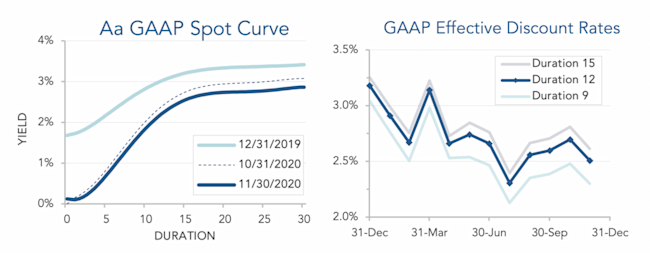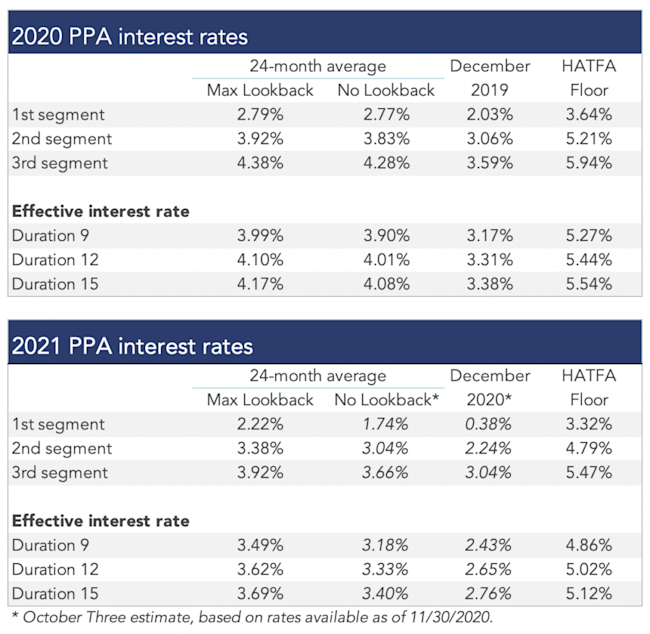
November 2020 Pension Finance Update
Stocks enjoyed their strongest month of the year in November, propelling pensions toward positive territory for the year. Both model plans we track gained ground last month, with Plan A adding close to 5% and Plan B close to 2% during the month. For the year, Plan A is down less than 1% and Plan B is even through the first eleven months of 2020.
Stocks enjoyed their strongest month of the year in November, propelling pensions toward positive territory for the year. Both model plans we track[1] gained ground last month, with Plan A adding close to 5% and Plan B close to 2% during the month. For the year, Plan A is down less than 1% and Plan B is even through the first eleven months of 2020:

Assets
Stock markets continued their remarkable 2020 recovery in November, with all major indexes adding 10% or more last month. For the year, a diversified stock portfolio is now up more than 14% through November, with tech (NASDAQ) overperforming massively while international markets lag.

Treasury yields fell modestly last month and corporate yields fell more as credit spreads returned to pre-crisis levels. The move produced gains of 1%-4% on bonds during November, with long duration corporates doing best. For the year, a diversified bond portfolio has gained 10%-13%, with long duration bonds producing the best returns.
Overall, our traditional 60/40 portfolio gained 8% in November and is now up 12% for the year, while the conservative 20/80 portfolio gained 4% last month and is now up 11% through the first eleven months of 2020.
Liabilities
Pension liabilities (for funding, accounting, and de-risking purposes) are driven by market interest rates. The first graph below compares our Aa GAAP spot yield curve at December 31, 2019 and November 30, 2020, and it also shows the decrease in the curve last month. The second graph below shows our estimate of movements in effective GAAP discount rates for pension obligations of various duration during 2020:

Corporate bond yields fell 0.2% in November, pushing pension liabilities up 2%-5%. Through the first eleven months of 2020, liabilities have increased 11%-15% for most plans, with long-duration plans seeing the largest increases.
Summary
At the beginning of 2020, few people anticipated that interest rates, already at record low levels, would move lower still, or that stock markets, already at record highs, would produce double-digit returns, but here we are. The good news for sponsors is that the stock market rally has effectively closed a “hole” in pension finances that emerged in the first quarter, leaving plans in a position similar to where they began the year. The graphs below show the movement of assets and liabilities for our two model plans during the first eleven months of the year:

Looking Ahead
Pension funding relief has reduced required plan funding since 2012, but this relief will gradually sunset. Plans that have only made required contributions in the past can expect significant increases in required contributions over the next couple years under current law.
The recent recovery for pension finances has reduced the danger that this experience will compound higher funding requirements due to the fading of funding relief. There is some chance we get more relief this year, but the recovery we have seen this year may make that less likely.
Discount rates moved lower last month. We expect most pension sponsors will use effective discount rates in the 2.2%-2.7% range to measure pension liabilities right now.
The table below summarizes rates that plan sponsors are required to use for IRS funding purposes for 2020, along with estimates for 2021. Pre-relief, both 24-month averages and December ‘spot’ rates, which are still required for some calculations, such as PBGC premiums, are also included.

[1] Plan A is a traditional plan (duration 12 at 5.5%) with a 60/40 asset allocation, while Plan B is a largely retired plan (duration 9 at 5.5%) with a 20/80 allocation with a greater emphasis on corporate and long-duration bonds. We assume overhead expenses of 1% of plan assets per year, and we assume the plans are 100% funded at the beginning of the year and ignore benefit accruals, contributions, and benefit payments in order to isolate the financial performance of plan assets versus liabilities.
